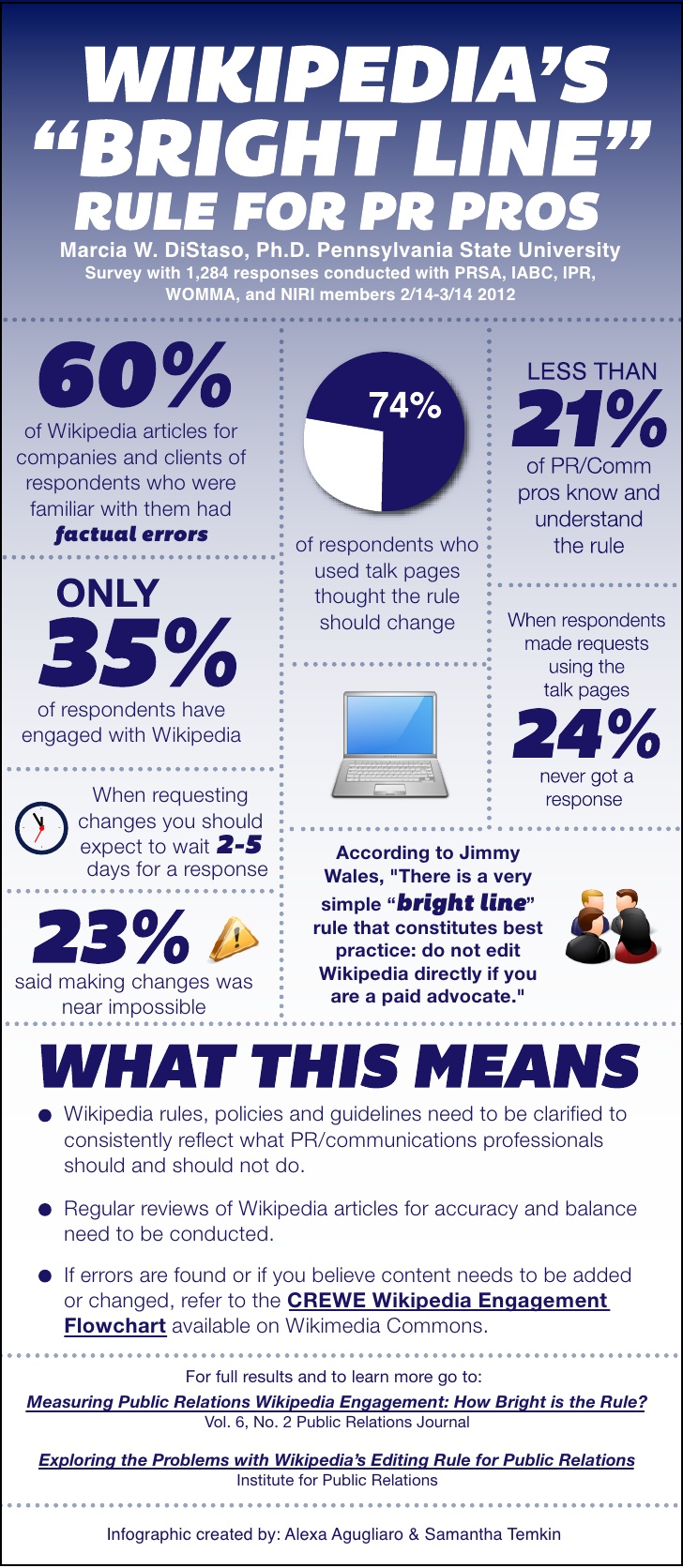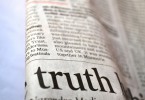Sixty percent of Wikipedia articles for companies and clients of respondents who were familiar with them had factual errors. That surprising number, and more, can be found in the infographic below, which is based on a research study of the relationship between public relations professionals and Wikipedia. The study is published in the Public Relations Society of America’s (PRSA) scholarly publication, Public Relations Journal.
The research was conducted by Marcia W. DiStaso, Ph.D., co-chair of PRSA’s National Research Committee and an assistant professor of public relations at Penn State University in State College, Pa. DiStaso surveyed 1,284 public relations professionals from PRSA, the International Association of Business Communicators, the Word of Mouth Marketing Association, the Institute for Public Relations and the National Investor Relations Institute to assess their working relationship with Wikipedia. The Arthur W. Page Center at Penn State’s College of Communications funded the research.
An article explaining the implications of that study is available through the Institute for Public Relations.
Wikipedia’s “Bright Line” Rule For PR Pros
PDF for Printing | Slideshare for Embedding








[…] professionals is available in an article published at the Institute for Public Relations. See the infographic on the PRSA blog for highlights of the two articles. The survey’s conclusion is that the […]
[…] Infographic: Measuring PR Pros’ Engagement with Wikipedia (PRSAY) Do you think PR professionals should use Wikipedia as a source? According to this study, 60 percent of Wikipedia articles contain factual errors. […]
[…] is an infographic about DiStaso’s research (h/t PRSA blog). Her research also found that a quarter of PR pros never check entries on Wikipedia, and of the 35 […]
[…] in a recent survey of PR professionals conducted by Marcia W. DiStaso, PhD., co-chair of PRSA’s National Research Committee, […]
[…] […]
I think it is really important in public relations to monitor what is being said about your client, and I think it is even more important to make sure that content is accurate. Wikipedia is a widely used source for information so it needs to have factual information. As long as whatever is being published is not opinion-based then public relations professionals should have the right to edit it. Obviously the public should not take everything posted on Wikipedia seriously, but enough people are looking at the site that its content should be monitored.
This research is very interesting, the headline “60% of articles contain factual errors” is completely misleading.
A more accurate statement would be that 32% of those PR people questioned said that one of their clients, or their own company’s Wikipedia article contained an error – these “factual errors” include 21% that are merely spelling errors.
It is not, of course, automatically the case that PR folk, who understand the effect that surveys have on public opinion are answering truthfully or unbiasedly, nor indeed is it guaranteed that they are right and Wikipedia is wrong. Even if we allow that they are in fact 100% correct and truthful, and ignore the spelling errors, one might hope that the average PR company has more than one client. Without taking this number into account the figure becomes completely meaningless.
[…] in a recent survey of PR professionals conducted by Marcia W. DiStaso, PhD., co-chair of PRSA’s National Research Committee, […]
[…] Safko, L. (2012). The Social Media Bible: Tactics, Tools, and Strategies for Business Success. 3rd ed. Wikipedia. (2014). Wikipedia: FAQ/Organisations. http://en.wikipedia.org/wiki/Wikipedia:FAQ/Organizations Xin Xu, S., & Xiaoquan (Michael), Z. (2013). Impact of Wikipedia on Market Information Environment. MIS Quarterly, 37(4), 1043-A10. Image: PRSay (2012). Infographic: Measuring PR Pros’ Engagement With Wikipedia.http://prsay.prsa.org/index.php/2012/04/17/measuring-the-relationship-between-wikipedia-and-public-r… […]
[…] http://prsay.prsa.org/index.php/2012/04/17/measuring-the-relationship-between-wikipedia-and-public-r… […]
[…] The concept of the Bright Line Rule on paid editing: the idea, introduced in 2012 by Wikipedia CEO Jimmy Wales, is that if you are paid […]
[…] “Es una cuestión ética”, puedes pensar. Pero en realidad es mucho más que eso. Es lo que se conoce como la “bright line rule”, que se resume así: “no PR people are allowed to edit Wikipedia”, en palabras de Christy Dena. Si no conocías esta normativa, tranquilo porque no eres el único: menos del 21% de los profesionales de la comunicación y las relaciones públicas dijo conocerla en 2012, según un estudio de la Public Relations Society of America que llevó a cabo Marcia W. DiStaso. […]